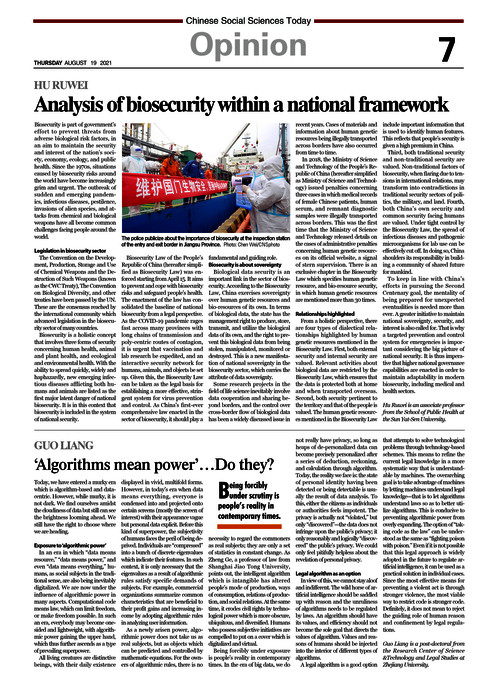Analysis of biosecurity within a national framework
2021-08-19 10:25:59
The police publicize about the importance of biosecurity at the inspection station of the entry and exit border in Jiangsu Province. Photo: Chen Wei/CNSphoto
Biosecurity is part of government’s effort to prevent threats from adverse biological risk factors, in an aim to maintain the security and interest of the nation’s society, economy, ecology, and public health. Since the 1970s, situations caused by biosecurity risks around the world have become increasingly grim and urgent. The outbreak of sudden and emerging pandemics, infectious diseases, pestilence, invasions of alien species, and attacks from chemical and biological weapons have all become common challenges facing people around the world.
Legislation in biosecurity sector
The Convention on the Development, Production, Storage and Use of Chemical Weapons and the Destruction of Such Weapons (known as the CWC Treaty), The Convention on Biological Diversity, and other treaties have been passed by the UN. These are the consensus reached by the international community which advanced legislation in the biosecurity sector of many countries.
Biosecurity is a holistic concept that involves three forms of security concerning human health, animal and plant health, and ecological and environmental health. With the ability to spread quickly, widely and haphazardly, new emerging infectious diseases afflicting both humans and animals are listed as the first major latent danger of national biosecurity. It is in this context that biosecurity is included in the system of national security.
Biosecurity Law of the People’s Republic of China (hereafter simplified as Biosecurity Law) was enforced starting from April 15. It aims to prevent and cope with biosecurity risks and safeguard people’s health. The enactment of the law has consolidated the baseline of national biosecurity from a legal perspective. As the COVID-19 pandemic rages fast across many provinces with long chains of transmission and poly-centric routes of contagion, it is urgent that vaccination and lab research be expedited, and an interactive security network for humans, animals, and objects be set up. Given this, the Biosecurity Law can be taken as the legal basis for establishing a more effective, stringent system for virus prevention and control. As China’s first-ever comprehensive law enacted in the sector of biosecurity, it should play a fundamental and guiding role.
Biosecurity is about sovereignty
Biological data security is an important link in the sector of biosecurity. According to the Biosecurity Law, China exercises sovereignty over human genetic resources and bio-resources of its own. In terms of biological data, the state has the management right to produce, store, transmit, and utilize the biological data of its own, and the right to prevent this biological data from being stolen, manipulated, monitored or destroyed. This is a new manifestation of national sovereignty in the biosecurity sector, which carries the attribute of data sovereignty.
Some research projects in the field of life science inevitably involve data cooperation and sharing beyond borders, and the control over cross-border flow of biological data has been a widely discussed issue in recent years. Cases of materials and information about human genetic resources being illegally transported across borders have also occurred from time to time.
In 2018, the Ministry of Science and Technology of the People’s Republic of China (hereafter simplified as Ministry of Science and Technology) issued penalties concerning three cases in which medical records of female Chinese patients, human serum, and remnant diagnostic samples were illegally transported across borders. This was the first time that the Ministry of Science and Technology released details on the cases of administrative penalties concerning human genetic resources on its official website, a signal of stern supervision. There is an exclusive chapter in the Biosecurity Law which specifies human genetic resource, and bio-resource security, in which human genetic resources are mentioned more than 30 times.
Relationships highlighted
From a holistic perspective, there are four types of dialectical relationships highlighted by human genetic resources mentioned in the Biosecurity Law. First, both external security and internal security are valued. Relevant activities about biological data are restricted by the Biosecurity Law, which ensures that the data is protected both at home and when transported overseas. Second, both security pertinent to the territory and that of the people is valued. The human genetic resources mentioned in the Biosecurity Law include important information that is used to identify human features. This reflects that people’s security is given a high premium in China.
Third, both traditional security and non-traditional security are valued. Non-traditional factors of biosecurity, when flaring due to tensions in international relations, may transform into contradictions in traditional security sectors of politics, the military, and land. Fourth, both China’s own security and common security facing humans are valued. Under tight control by the Biosecurity Law, the spread of infectious diseases and pathogenic microorganisms for lab use can be effectively cut off. In doing so, China shoulders its responsibility in building a community of shared future for mankind.
To keep in line with China’s efforts in pursuing the Second Centenary goal, the mentality of being prepared for unexpected eventualities is needed more than ever. A greater initiative to maintain national sovereignty, security, and interest is also called for. That is why a targeted prevention and control system for emergencies is important considering the big picture of national security. It is thus imperative that higher national governance capabilities are enacted in order to maintain adaptability in modern biosecurity, including medical and health sectors.
Hu Ruwei is an associate professor from the School of Public Health at the Sun Yat-Sen University.


